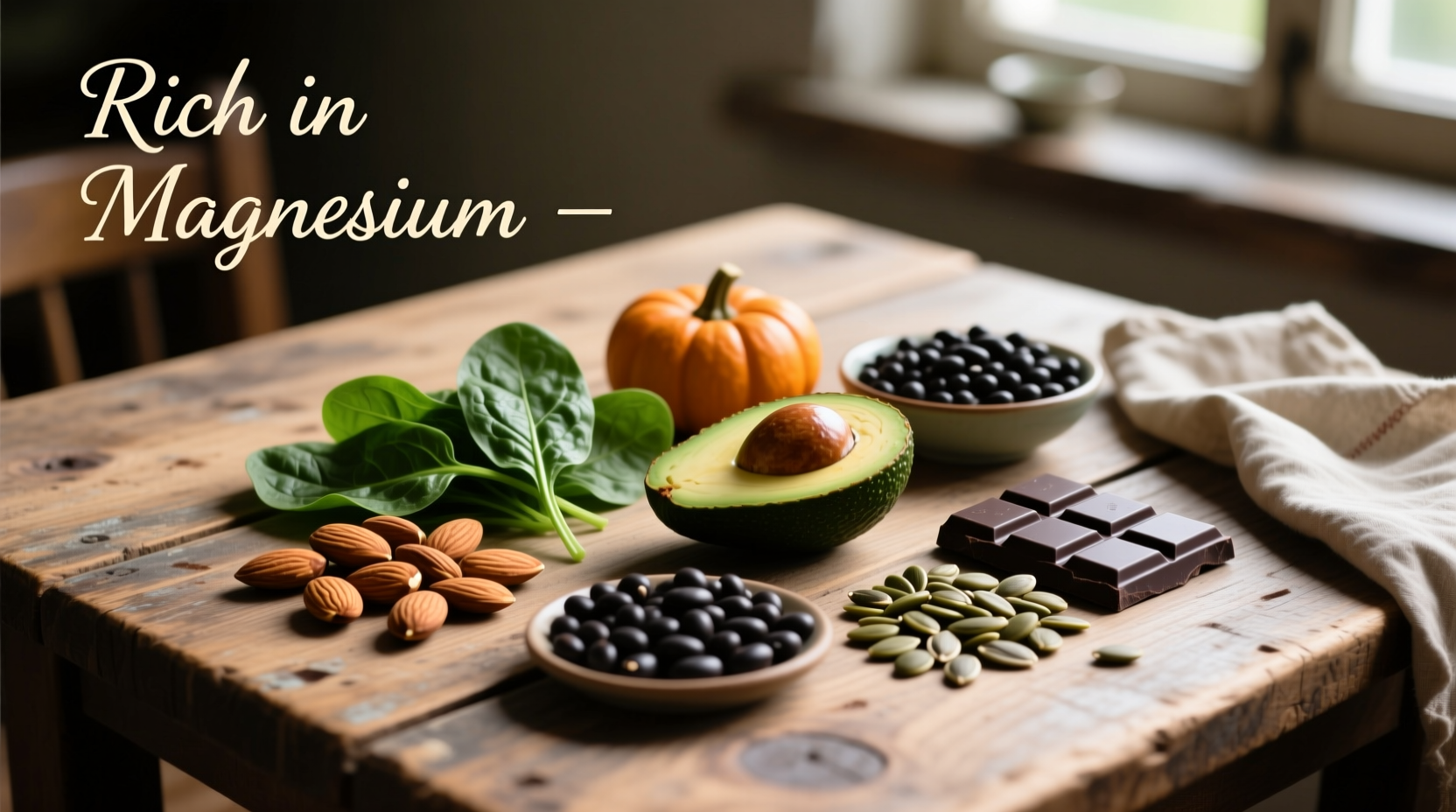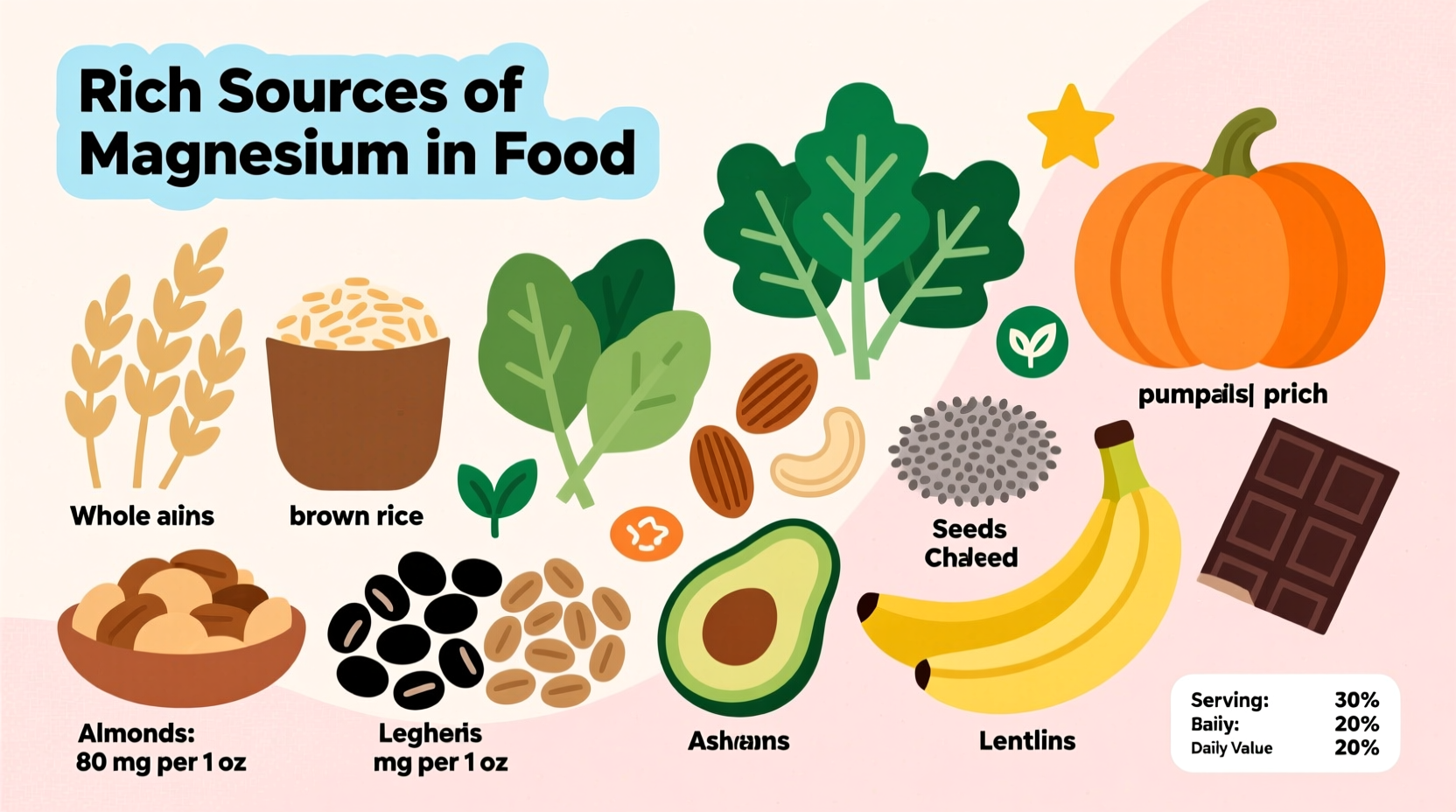Discover exactly which foods pack the most magnesium and how to effortlessly incorporate them into your daily meals. This guide reveals science-backed magnesium sources ranked by concentration, practical meal combinations, and simple strategies to maximize absorption—so you can boost energy, support muscle function, and improve sleep quality through food alone.
Why Magnesium Matters More Than You Think
Magnesium isn't just another mineral—it's a cofactor in over 300 enzymatic reactions in your body. From converting food into energy to regulating neurotransmitters that influence mood and sleep, this essential nutrient impacts nearly every bodily system. Research from the National Institutes of Health shows that nearly 50% of Americans don't meet daily magnesium requirements, potentially contributing to fatigue, muscle cramps, and even cardiovascular issues.
| Age/Gender Group | Daily Magnesium Requirement | Key Dietary Sources |
|---|---|---|
| Men 19-30 years | 400 mg | Spinach, almonds, black beans |
| Women 19-30 years | 310 mg | Quinoa, avocado, yogurt |
| Men 31+ years | 420 mg | Salmon, pumpkin seeds, dark chocolate |
| Women 31+ years | 320 mg | Edamame, bananas, brown rice |
Top 10 Magnesium Powerhouses (Ranked by Concentration)
1. Pumpkin Seeds: The Magnesium Champion
With 156mg per ounce (37% of daily value), pumpkin seeds are magnesium royalty. These versatile seeds retain their nutrient density whether raw or roasted. For maximum benefit, choose raw, unsalted varieties and incorporate them into your diet by:
- Sprinkling on morning oatmeal or yogurt
- Blending into homemade energy bars
- Creating a magnesium-boosting pesto (substitute half the basil with spinach)
2. Spinach and Other Leafy Greens
One cup of cooked spinach delivers 157mg of magnesium (37% DV). The magnesium in greens comes packaged with vitamin K and folate, creating a synergistic nutritional profile. Cooking increases bioavailability—steaming preserves more nutrients than boiling. Try massaging raw spinach with lemon juice to break down cell walls and enhance magnesium absorption.

3. Black Beans and Legumes
One cup of cooked black beans provides 120mg (29% DV). The fiber in legumes slows digestion, creating a steady release of magnesium into your system. Soaking beans before cooking reduces phytates that can inhibit mineral absorption. Pair with vitamin C-rich foods like bell peppers to boost magnesium uptake by up to 30%, according to research published in the Journal of Nutrition and Metabolism.
Hidden Magnesium Sources You're Probably Missing
Dark Chocolate: The Delicious Surprise
That craving for chocolate might actually be your body seeking magnesium! A 1-ounce serving of dark chocolate (70-85% cacao) contains 64mg (15% DV). The magnesium in cocoa supports serotonin production, explaining why quality dark chocolate improves mood. Choose minimally processed varieties with at least 70% cacao for maximum benefits without excessive sugar.
Fatty Fish: Beyond Omega-3s
Salmon and mackerel provide 50-60mg per 3-ounce serving (12-14% DV). The healthy fats in these fish enhance magnesium absorption while the mineral itself supports the conversion of omega-3s into their active forms. Grill or bake instead of frying to preserve both magnesium content and beneficial fatty acids.
Maximizing Magnesium Absorption: Practical Strategies
Simply eating magnesium-rich foods isn't enough—you need to optimize absorption. Consider these evidence-based approaches:
Pair with Vitamin D and B6
Vitamin D enhances intestinal magnesium absorption. Enjoy salmon (which contains both nutrients) or pair fortified plant milks with magnesium-rich foods. Vitamin B6, found in bananas and chickpeas, helps transport magnesium into cells.
Avoid Magnesium Blockers
High sodium intake increases magnesium excretion. The typical Western diet's 3,400mg daily sodium (compared to the recommended 1,500mg) can deplete magnesium stores. Reduce processed foods and add magnesium-rich herbs like basil and cilantro for flavor instead of salt.
Recognizing Magnesium Deficiency: Subtle Signs
Mild magnesium deficiency often manifests as:
- Unexplained muscle cramps or spasms
- Difficulty falling asleep despite fatigue
- Increased sensitivity to stress
- Nighttime leg twitching
These symptoms frequently go unrecognized because blood tests don't accurately reflect total body magnesium stores. The Mayo Clinic notes that only 1% of magnesium exists in blood serum—the rest is stored in bones and tissues.
Your 7-Day Magnesium Meal Plan
Transform your magnesium intake with this practical weekly framework:
Monday
Breakfast: Spinach and feta omelet with whole grain toast
Lunch: Quinoa salad with black beans, pumpkin seeds, and avocado
Dinner: Baked salmon with roasted Brussels sprouts and sweet potato
Tuesday
Breakfast: Greek yogurt with almonds and banana
Lunch: Lentil soup with whole grain roll
Dinner: Chicken stir-fry with edamame and brown rice
Continue this pattern, rotating through different magnesium sources to ensure variety and prevent dietary boredom. Each day should include at least three magnesium-rich components from different food groups.
When Food Isn't Enough: Considering Supplements
While food should be your primary magnesium source, certain conditions may warrant supplementation:
- Type 2 diabetes (increases urinary magnesium excretion)
- Gastrointestinal disorders like Crohn's disease
- Long-term proton pump inhibitor use
- Chronic alcohol consumption
If considering supplements, choose magnesium glycinate or malate for best absorption. Avoid magnesium oxide, which has only 4% bioavailability according to research in the Journal of Nutrition and Metabolism.











 浙公网安备
33010002000092号
浙公网安备
33010002000092号 浙B2-20120091-4
浙B2-20120091-4